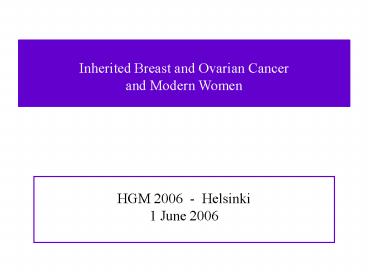Inherited Breast and Ovarian Cancer - PowerPoint PPT Presentation
1 / 36
Title:
Inherited Breast and Ovarian Cancer
Description:
Inherited Breast and Ovarian Cancer and Modern Women HGM 2006 - Helsinki 1 June 2006 Common disease - many, individually rare alleles Second, somatic events due to ... – PowerPoint PPT presentation
Number of Views:256
Avg rating:3.0/5.0
Title: Inherited Breast and Ovarian Cancer
1
Inherited Breast and Ovarian Cancer and Modern
Women
HGM 2006 - Helsinki 1 June 2006
2
Rose Frisch, 2003
3
(No Transcript)
4
BRCA1 and BRCA2
gt1000 mutations of BRCA1 gt1000 mutations of
BRCA2 All cancer-associated mutations are
individually rare
5
Family 1. BRCA1.2800 DAA
2-hit model for adult onset cancers
6
Family 16. BRCA2.1529 D AAAG 456 stop
7
Family 77. BRCA1.5677insA 1853 stop
8
Functions of BRCA1 Ubiquitination, DNA repair,
transcriptional regulation
RING
BRCT
1575 1863
1 110
p53
RAD51
BRCA2
BARD1
BAP1
MSH2
RB1
UBCH5C
CtIP
ZBRK1
ATF1
RNA Hel A
RAD50
E2F
HDAC 1/2
RNA Pol II
MSH2
p300/CBP
ERa
BACH1
9
Family 4. BRCA1. 300 G gt C Cys 61 Gly
Point mutation in RING domain
10
BRCA1
BARD1
4-helix bundle
Site I
Site I
Central helix
Site II
Peter Brzovic Rachel Klevit
11
BRCA1
BARD1
Loss of ubiquitin ligase activity
4-helix bundle
Site I
Site I
Central helix
Site II
Peter Brzovic Rachel Klevit
12
D 307 aa from BRCT domain
13
Family 87. BRCA1. D 69226-80582 D exons 20-22
exon 20 71598-71681 exon 21 77620-77674 exon
22 79543-79616
14
Duplications and deletions at BRCA1 and BRCA2 in
300 families
Blue BRCA1 and BRCA2 genes, red deletions,
yellow duplications
15
Duplications and deletions at BRCA1 and BRCA2 in
300 families
Blue BRCA1 and BRCA2 genes, red deletions,
yellow duplications
12 of high-risk families with wildtype
commercial test results carry genomic
rearrangements at BRCA1 or BRCA2
16
What are the risks of breast and ovarian cancer
due to inherited mutations in BRCA1 or
BRCA2? New York Breast Cancer Study
17
Trace mutations through the families, then
determine cancer experience of female relatives
with mutations
18
Risk of breast cancer for relatives with BRCA1 or
BRCA2 mutations not selected for age at diagnosis
or family history
19
Families with BRCA1/2 mutations with low
incidence of cancer
Are these families low risk (as well as low
incidence)?
20
Risk of breast cancer for relatives with BRCA1 or
BRCA2 mutations Low-incidence families
21
Low cancer incidence in an extended family By
chance, distant female relatives do not carry
mutations
BRCA2 6174DT
Complete genotyping is important
22
High cancer incidence among female relatives with
mutation
BRCA1 5382insC
23
Risk of breast cancer for relatives with BRCA1 or
BRCA2 mutations Effect of birth cohort
24
Age at breast cancer diagnosis among probands by
genotype and pregnancy history, adjusted for
birthyear
25
Age at breast cancer diagnosis among probands
with BRCA mutations by physical activity as a
teenager, adjusted for birthyear
26
Risk of ovarian cancer for relatives with BRCA1
or BRCA2 mutations
.02
.21
.40
.46
.54
BRCA1
BRCA2
.02
.02
.06
.12
.23
27
Occult cancers detected at prophylactic surgery
291.BRCA1.3795 D4
294.BRCA1.2800DAA
295.BRCA1.2800DAA
Fallopian tube early invasive
Fallopian tube in situ
Primary peritoneal IIIc
28
Mutations in CHEK2 associated with breast cancer
29
Proportion of familial breast cancer due to
mutations in known genes
All families
Female breast cancer only
30
Families with gt4 cases of breast cancer Wildtype
at BRCA1, BRCA2, CHEK2, p53, PTEN
300 more
31
Haplotypes in the AJ population at the CHEK2
region of 22q
32
Genome-wide screen for founder mutations in novel
genes Long haplotypes shared by multiple (not
all!) affected families
Mother-daughter pairs with breast cancer from a
founder population (AJ)
Sequence genes from longest haplotypes
33
Phylogeny of haplotypes spanning 2MB on 8q
34
Conclusions
Common disease - many, individually rare
alleles Second, somatic events due to genomic
structure Genetic heterogeneity of both loci and
alleles Reduced heterogeneity in founder
populations Haplotype length as a mapping
tool Indicator mutations where there is one,
there will be more..
35
University of Washington Tom Walsh Silvia
Casadei Jake Higgins Kevin Roach Avraham
Shaag Sunday Stray Jessica Mandell Ming
Lee Elizabeth Swisher Peter Brzovic Rachel
Klevit
Share Zedek-Hebrew University Paul
Renbaum Ephrat Levy-Lahad
Czech and Slovak Republics Sona Ciernikova
Lenka Foretova Pavel Soucek
36
Thank you for inviting me to Helsinki!































